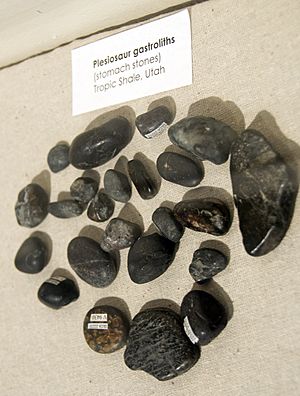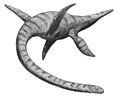Plesiosaur facts for kids
Quick facts for kids Plesiosaur |
|
|---|---|
 |
|
| Scientific classification | |
| Kingdom: | |
| Phylum: | |
| Class: | |
| Superorder: | |
| Order: |
Plesiosauria
|
| Suborder: |
Plesiosauroidea
Pliosauroidea Gray, 1825
|
Plesiosaurs were a group of big, meat-eating reptiles that lived in the ocean. They were around for a very long time, from about 245 million years ago until 65 million years ago. This means they lived during the Triassic, Jurassic, and Cretaceous periods.
The first time anyone described a plesiosaur skeleton was in 1719. A scientist named William Stukeley wrote about it. But the most famous discovery was made by Mary Anning. She was a fossil hunter who found a nearly complete plesiosaur skeleton in England around 1820. It was missing its head, but she found another one with a skull a few years later! A person named Rev. William Conybeare gave it the name Plesiosaurus.
Plesiosaurs had two large pairs of paddles, like flippers. They had short tails and wide bodies. Some had short necks, and others had very long necks. They all died out about 65 million years ago during a big event called the K/T extinction event, which also wiped out the dinosaurs.
Contents
What Plesiosaurs Looked Like
Plesiosaurs had many bones in their flippers. This made their flippers very flexible, helping them swim. No animal alive today has this four-flipper body plan. Modern turtles, for example, only use their front flippers for swimming. Most plesiosaurs ate fish.
Short-Necked Plesiosaurs: Pliosaurs
The pliosaurs were a group of plesiosaurs with short necks and big heads. They were powerful hunters in the ocean. Their sizes ranged from about 2 meters (6.5 feet) to 15 meters (50 feet) long. Pliosaurs hunted large fish and other reptiles. Their smooth, streamlined bodies suggest they were fast swimmers that hunted underwater.
- Liopleurodon is a well-known pliosaur.
Long-Necked Plesiosaurs

There were three main groups of long-necked plesiosaurs. They probably lived differently from the short-necked pliosaurs. Some scientists think they swam near the surface of the water, diving down quickly to catch smaller fish. It's hard to see why a long neck would be helpful deep underwater. Most sea animals that hunt underwater have a smooth, torpedo-like shape, just like pliosaurs.
The long-necked plesiosaurs had teeth and jaws that were good for eating small fish. However, some of them also ate animals from the ocean floor. They even swallowed stones called gastroliths to help them digest their food.
- Plesiosaurids: These had necks that were not as long or flexible as the other two groups. They were more general plesiosaurs with a medium-sized head and a fairly thick, strong neck. They could have up to 30 neck bones (vertebrae).
- Plesiosaurus is a famous example.
- Cryptoclidids: These had longer necks with more than 30 neck bones.
- Cryptoclidus is an example.
- Elasmosaurids: These had very long necks. Some later types had as many as 76 neck bones and quite small skulls.
- Elasmosaurus
- Thalassomedon
- Mauisaurus, which was the longest plesiosaur ever found.
Stomach Stones: Gastroliths
Scientists have found plesiosaur fossils with "stomach stones" inside them. These stones are called gastroliths. They were found near where the plesiosaur's stomach would have been. These stones probably helped the plesiosaur grind up the food it ate, like belemnites (which were like ancient squid) and ammonites (which were like giant nautiluses). Plesiosaurs couldn't chew or crack shells, so they likely swallowed their prey whole. The gastroliths would then tumble around in their stomach, helping to crush the shells. One plesiosaur fossil found in South Dakota had 253 gastroliths that weighed a total of 29 pounds!
How Plesiosaurs Gave Birth
We know that ichthyosaurs (another type of ancient marine reptile) gave birth to live young, just like dolphins do today. However, it is not certain if plesiosaurs also gave birth to live young or laid eggs.
Images for kids
-
Nothosaurs still had functional legs
-
Plesiosaur skeleton of Meyerasaurus in the Museum am Löwentor, Stuttgart, seen from below
-
Cast of the "Puntledge River elasmosaur", Canadian Museum of Nature
-
A short-necked pliosaurid like Kronosaurus would have been capable of overtaking a long-necked plesiosaur that, however, would be more manoeuvrable.
See also
 In Spanish: Plesiosaurios para niños
In Spanish: Plesiosaurios para niños



















